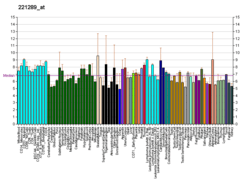DLX6
Homeobox protein DLX-6 is a protein that in humans is encoded by the DLX6 gene.[5][6]
This gene encodes a member of a homeobox transcription factor gene family similar to the Drosophila distal-less gene. This family has at least six members that encode proteins with roles in forebrain and craniofacial development. This gene is in a tail-to-tail configuration with another member of the family on the long arm of chromosome 7.[6]
References
- 1 2 3 GRCh38: Ensembl release 89: ENSG00000006377 - Ensembl, May 2017
- 1 2 3 GRCm38: Ensembl release 89: ENSMUSG00000029754 - Ensembl, May 2017
- ↑ "Human PubMed Reference:".
- ↑ "Mouse PubMed Reference:".
- ↑ Simeone A, Acampora D, Pannese M, D'Esposito M, Stornaiuolo A, Gulisano M, Mallamaci A, Kastury K, Druck T, Huebner K, et al. (Apr 1994). "Cloning and characterization of two members of the vertebrate Dlx gene family". Proc Natl Acad Sci U S A. 91 (6): 2250–4. doi:10.1073/pnas.91.6.2250. PMC 43348. PMID 7907794.
- 1 2 "Entrez Gene: DLX6 distal-less homeobox 6".
Further reading
- Crackower MA, Scherer SW, Rommens JM, et al. (1997). "Characterization of the split hand/split foot malformation locus SHFM1 at 7q21.3-q22.1 and analysis of a candidate gene for its expression during limb development". Hum. Mol. Genet. 5 (5): 571–9. doi:10.1093/hmg/5.5.571. PMID 8733122.
- Charité J, McFadden DG, Merlo G, et al. (2001). "Role of Dlx6 in regulation of an endothelin-1-dependent, dHAND branchial arch enhancer". Genes Dev. 15 (22): 3039–49. doi:10.1101/gad.931701. PMC 312822. PMID 11711438.
- Depew MJ, Lufkin T, Rubenstein JL (2002). "Specification of jaw subdivisions by Dlx genes". Science. 298 (5592): 381–5. doi:10.1126/science.1075703. PMID 12193642.
- Strausberg RL, Feingold EA, Grouse LH, et al. (2003). "Generation and initial analysis of more than 15,000 full-length human and mouse cDNA sequences". Proc. Natl. Acad. Sci. U.S.A. 99 (26): 16899–903. doi:10.1073/pnas.242603899. PMC 139241. PMID 12477932.
- Nabi R, Zhong H, Serajee FJ, Huq AH (2004). "No association between single nucleotide polymorphisms in DLX6 and Piccolo genes at 7q21-q22 and autism". Am. J. Med. Genet. B Neuropsychiatr. Genet. 119 (1): 98–101. doi:10.1002/ajmg.b.10012. PMID 12707945.
- Hillier LW, Fulton RS, Fulton LA, et al. (2003). "The DNA sequence of human chromosome 7". Nature. 424 (6945): 157–64. doi:10.1038/nature01782. PMID 12853948.
- Ota T, Suzuki Y, Nishikawa T, et al. (2004). "Complete sequencing and characterization of 21,243 full-length human cDNAs". Nat. Genet. 36 (1): 40–5. doi:10.1038/ng1285. PMID 14702039.
- Gerhard DS, Wagner L, Feingold EA, et al. (2004). "The status, quality, and expansion of the NIH full-length cDNA project: the Mammalian Gene Collection (MGC)". Genome Res. 14 (10B): 2121–7. doi:10.1101/gr.2596504. PMC 528928. PMID 15489334.
- Schüle B, Li HH, Fisch-Kohl C, et al. (2007). "DLX5 and DLX6 expression is biallelic and not modulated by MeCP2 deficiency". Am. J. Hum. Genet. 81 (3): 492–506. doi:10.1086/520063. PMC 1950824. PMID 17701895.
This article is issued from
Wikipedia.
The text is licensed under Creative Commons - Attribution - Sharealike.
Additional terms may apply for the media files.




